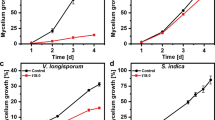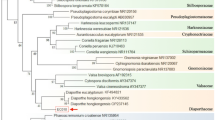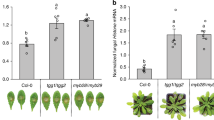Abstract
SEVERAL workers1–5 have postulated the production of some non-enzymatic phytotoxins by Rhizoctonia solani Kühn, a pathogen having a wide range of plants as hosts; but the chemical constitution of the toxins is yet unknown. Recently, Sherwood and Lindberg6 reported that this toxin was a phenolic and glycosidic substance from the results of paper chromatogram and biological tests; but no substance was identified on the paper. We have already reported that the culture filtrate of R. solani gave phenylacetic acid, a well-known plant growth regulator, and the acid could inhibit the growth of roots of seedlings at concentrations above 0.05 per cent for sugar beet, and 0.005 per cent for rape and rice plant respectively7. Phenylacetic acid, however, did not cause necrosis, which was a characteristic phenomenon of the root rot, therefore it seemed likely that the acid was not the principal phytotoxin produced by this fungus. In this communication, a further investigation on isolating phytotoxins is shown.
Similar content being viewed by others
Article PDF
References
Newton, W., and Mayers, N., Sci. Agric., 15, 399 (1935).
Boosalis, M. G., Phytopath., 40, 820 (1950).
Kerr, A., Austral. J. Biol. Sci., 9, 45 (1956).
Deshpande, K. B., Biol. Plant. Acad. Sci. Bohemoslov, 2, 139 (1960); Chem. Abst., 55, 699.
Wyllie, T. D., Phytopath., 52, 202 (1962).
Sherwood, R. T., and Lindberg, C. G., Phytopath., 52, 586 (1962).
Aoki, H., Tamura, T., and Sassa, T., Ann. Meeting Agric. Chem. Soc. Japan (April 29, 1962).
Chen, Y., Bull. Agric. Chem. Soc. Japan, 22, 136 (1958).
Author information
Authors and Affiliations
Rights and permissions
About this article
Cite this article
AOKI, H., SASSA, T. & TAMURA, T. Phytotoxic Metabolites of Rhizoctonia solani. Nature 200, 575 (1963). https://doi.org/10.1038/200575a0
Issue Date:
DOI: https://doi.org/10.1038/200575a0
This article is cited by
-
Identification of effector candidate genes of Rhizoctonia solani AG-1 IA expressed during infection in Brachypodium distachyon
Scientific Reports (2020)
-
Chemotaxonomy of fungi in the Rhizoctonia solani species complex performing GC/MS metabolite profiling
Metabolomics (2013)
-
Methanol extract from mycelium of endophytic fungus Rhizoctonia sp. induces antinociceptive and anti-inflammatory activities in mice
Journal of Natural Medicines (2011)
-
High-resolution mapping of Rsn1, a locus controlling sensitivity of rice to a necrosis-inducing phytotoxin from Rhizoctonia solani AG1-IA
Theoretical and Applied Genetics (2011)
-
1H NMR and GC-MS metabolic fingerprinting of developmental stages of Rhizoctonia solani sclerotia
Metabolomics (2010)
Comments
By submitting a comment you agree to abide by our Terms and Community Guidelines. If you find something abusive or that does not comply with our terms or guidelines please flag it as inappropriate.



